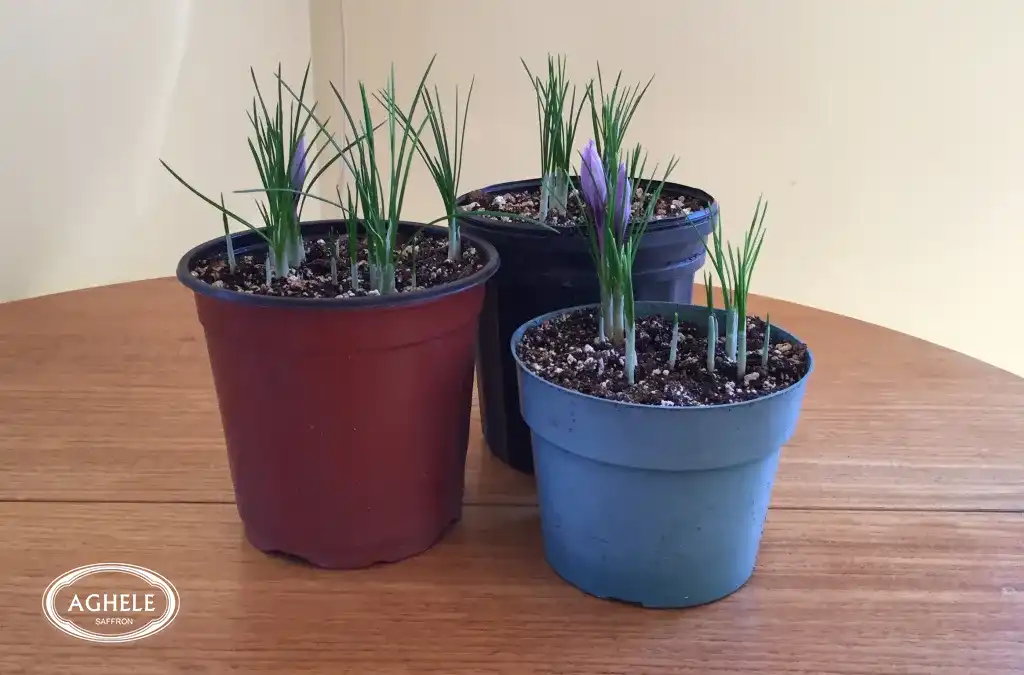As you know, saffron is a valuable and precious spice, and those who cultivate saffron can often earn significant profits from it. Therefore, understanding the conditions for growing saffron is essential for those who are interested in it. One of the advantages of saffron cultivation is that the plant does not require a lot of water and can grow in arid areas. To know how to plant saffron and harvest it in the best possible way, it is important first to understand the suitable climate for saffron cultivation.
You can purchase authentic and high-quality saffron from this section. You can also check the latest saffron prices on the Aghele website, where we update the prices daily.
In What Climate Is Saffron Cultivated?
Most people cultivate saffron in warm climates, but it can also be grown in cold climates. Generally, saffron can tolerate temperatures ranging from -30°C to +40°C and grows well in areas located at an altitude of 400 to 2,300 meters above sea level.
One of the important conditions for saffron cultivation is that areas receiving more than 30 millimeters of rainfall in the second half of summer are not suitable for saffron cultivation.
The Best Season for Planting Saffron (Ideal Time for Saffron Cultivation)
Saffron bulbs go through a dormancy and active period, and the best time to plant saffron is during the dormancy of the bulb.
The best season to plant saffron is roughly from late June to late September. However, this time can vary slightly depending on the region:
– Cold regions: Late September
– Semi-warm regions: Early October
– Warm regions: Late October

Methods of Saffron Cultivation:
Saffron cultivation involves specific techniques and principles that must be followed carefully to obtain a high-quality and productive crop. Due to the high value of this plant and its low water requirements, saffron cultivation is one of the best options for areas with dry and semi-arid climates.
Saffron Cultivation in Agricultural Land:
Cultivating saffron on agricultural land requires precise preparation and adherence to specific principles. The first step is to prepare the land, which involves plowing and removing stones and weeds from the soil. The soil suitable for saffron cultivation should have good drainage to ensure water passes through easily and the bulbs do not rot. After preparing the land, healthy and rot-free saffron bulbs are planted at a depth of 15 to 20 centimeters in the soil. The distance between bulbs should be about 10 centimeters, and the distance between rows should be between 20 and 30 centimeters.
Care for the land after planting includes regular watering and weed control. Saffron does not require much water, but proper irrigation during the initial growing and flowering seasons can significantly improve the quality of the crop. Additionally, monitoring the land to prevent pests and diseases and using natural methods to control these issues is essential. By following these steps, farmers can achieve a high-quality and productive saffron crop.
Greenhouse Saffron Cultivation:
Greenhouse saffron cultivation is one of the modern and effective methods for producing high-quality saffron with a high yield. In this method, saffron bulbs are planted in a controlled greenhouse environment, allowing for better control of temperature, humidity, and light. This method is particularly beneficial in regions where outdoor conditions are not suitable for saffron cultivation. In the greenhouse, the bulbs are placed in cultivation trays or special pots and benefit from nutrient-rich soil and proper feeding.
One of the advantages of greenhouse saffron cultivation is the reduced water consumption and the ability to more precisely control diseases and pests. This method also enables the production of higher-quality saffron and a greater number of flowers due to optimized growing conditions. However, the need for an initial investment in building the greenhouse and necessary equipment is one of the challenges of this method.
Saffron Cultivation in Pots:
Saffron cultivation in pots is an ideal method for those who want to grow this plant in small or indoor spaces. To begin, you should select pots with enough depth to allow the saffron bulbs sufficient space to grow. The ideal soil for saffron should have good drainage and consist of a mixture of garden soil, sand, and some compost. The bulbs are planted at a depth of about 10 to 15 centimeters, and regular watering is necessary to keep the soil moist, but care should be taken to prevent waterlogging.
Growing saffron in pots can result in higher-quality flowers due to better control of environmental factors such as light and temperature. This method is especially suitable for individuals living in cold regions or areas with unsuitable climates for outdoor saffron cultivation. Regular care of the plant and providing optimal growing conditions can help increase the yield and quality of the produced saffron
Saffron Cultivation in Boxes:
To plant saffron in boxes, you can follow the same method as planting in pots. It doesn’t matter whether the box is plastic or wooden; the important thing is that it has drainage holes at the bottom. It is best to plant the bulbs from June to September. If you’re interested in growing saffron without soil and learning about the income potential of home saffron cultivation, you can read the article on saffron cultivation income.
Conditions for Saffron Cultivation:
Choosing the right environmental conditions is crucial for saffron cultivation. Saffron requires well-drained soil to prevent water accumulation, as its roots are sensitive to excess moisture, which can cause the bulbs to rot. The ideal soil pH should be between 6 and 8, and a mixture of garden soil, sand, and a bit of compost provides the necessary nutrients. Additionally, direct sunlight is essential for optimal saffron growth, so locations that receive 6 to 8 hours of daily sunlight are the best choice.
The ideal temperature for saffron cultivation is between 15 and 20°C. While the plant can grow in lower temperatures, it requires more care. During the summer, saffron especially needs high and dry temperatures for the bulbs and flowers to develop well. Watering should be adjusted to keep the soil slightly moist at all times, but overwatering and waterlogging should be avoided. By maintaining these conditions, you can expect to improve the quality and yield of saffron.
Suitable Saffron Bulbs for Planting:
Before purchasing saffron bulbs, it is important to know that the bulbs should be disinfected before planting to prevent fungal and mite infestations. If you can obtain high-quality, pre-disinfected bulbs, it will make the process easier. If disinfected bulbs are not available, you can prepare a solution by mixing water with pesticides like Tuzet, Sarzan, and others, then soak the bulbs in it. Be cautious not to leave the bulbs in the solution for too long, as they may get damaged.
Saffron bulbs come in three sizes: small, medium, and large. It is advisable to choose small or medium-sized bulbs because, after a few years, the bulb volume will double. The required amount of bulbs per square meter is about 1 kilogram, so based on this, you can calculate the number of bulbs needed for your cultivation area.
Suitable Soil for Saffron Cultivation:
The best soil for planting saffron is sandy loam soil, and the ideal soil pH for cultivation should be between 7 and 8. Additionally, the soil salinity or EC should be below 3,000.
How to Plant Saffron Bulbs:
When planting saffron bulbs, choosing and preparing the right location is crucial. Saffron requires well-drained soil and sufficient sunlight. You should plant saffron bulbs from late summer to early fall at the appropriate depth and spacing. The planting depth should allow the bulbs to grow comfortably and avoid freezing. Typically, a depth of 10 to 15 centimeters is suitable, and the spacing between bulbs should be about 10 to 15 centimeters for optimal growth.
After planting, it is important to keep the soil moist but avoid overwatering. Saffron prefers dry or slightly moist soil over waterlogged conditions. Regular watering is needed, but in rainy seasons, it’s essential to monitor the soil moisture. Additionally, providing the right temperature conditions is important, as saffron is sensitive to extreme cold and should be protected from freezing.
During the growing season, it is important to manage weeds and pests, using natural or appropriate control methods when necessary. Saffron also requires specific care in terms of nutrition, so it is recommended to use balanced fertilizers to ensure the plant gets proper nourishment. After flowering and harvesting the saffron, the bulbs should be properly stored to ensure they can continue growing in the next season.
Watering Saffron Bulbs:
As mentioned earlier, saffron is a drought-tolerant plant, and its bulbs only require moisture during the growth period. The saffron bulb’s growth period includes two phases: flowering in the fall and bulb propagation in winter and spring. The moisture needed by saffron bulbs is usually provided through rainfall, but generally, you should water the field 2 to 4 times a year. The best time to water saffron is during the flowering period, which occurs in October.
The second watering, aimed at fertilization, should take place after harvesting the flowers, between late November and mid-December. If winter rainfall during a rainfall period does not reach 50 millimeters, the third and fourth watering should be done in March and April. By following these tips for saffron planting and watering, you can expect a good harvest.
Saffron Harvesting:
Harvesting saffron is a delicate and important phase in the production of this valuable plant. Saffron is usually harvested from late October to early November when the flowers are in full bloom. Careful handling is essential during this stage, as saffron flowers should be gently picked from the ground to avoid damaging the saffron stigmas. The flowers are hand-picked, and skilled labor is required, as each flower contains only a few stigmas, and any damage to the flowers can negatively affect the quality of the saffron.
After harvesting the flowers, the process of drying the saffron begins. To maintain the quality of saffron, the stigmas must be dried quickly and carefully. This is usually done in dry environments with proper air circulation to prevent moisture and spoilage. Traditionally, saffron is dried on cotton cloths or in drying machines. This stage is crucial because excess moisture can harm the quality and fragrance of the saffron.
After Drying:
Once dried, saffron must be carefully sorted and packaged. The dried saffron should be stored in airtight containers in a cool and dry environment to protect it from environmental factors and external contaminants. It is also essential to avoid exposure to direct sunlight and moisture, as these factors can significantly affect the quality and aroma of the saffron. Proper harvesting and storage can help maintain the quality and commercial value of this product.
In general:
We hope that by following the necessary tips, you will have a successful saffron harvest and achieve good sales. After harvesting the saffron, it needs to be dried. At Aghele Saffron, we have an article titled “6 Easy Methods for Drying Saffron,” which can help you choose the best method.

